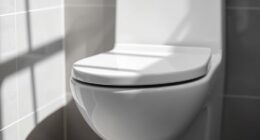I gotta tell you, finding the perfect toilet height can be a real pain in the you-know-what. But fear not, my friend, because in this article, I’m gonna break it down for you.
We’re talking about the difference between comfort and standard height toilets and how to choose the right one for your needs.
Comfort height toilets are great for tall folks and those who need a little extra accessibility. But they might not be the best fit for shorter adults or kiddos.
On the other hand, standard height toilets are your everyday go-to, suitable for most people.
So let’s dive in and find the perfect throne for you!
Key Takeaways
- Comfort height toilets, measuring 17 inches or more, are a popular choice for tall people, the elderly, and the disabled.
- They provide a more comfortable toilet experience and are ADA compliant, making them suitable for wheelchair users.
- However, comfort height toilets may be too high for children and uncomfortable for shorter adults, potentially leading to thigh pain and loss of circulation.
- Standard height toilets, with an average seat height of 15 inches, are the most common toilets found in homes and are suitable for average-sized people, smaller adults, and children.
The Importance of Toilet Height for Comfort and Accessibility
For me, as a tall person, the height of a toilet is important for both comfort and accessibility. When it comes to toilet height for people with physical disabilities and elderly individuals, it becomes even more crucial to choose the right height.
Comfort height toilets, which measure 17 inches or more, are a popular choice for these individuals. They provide a more comfortable experience and are ADA compliant, making them suitable for wheelchair users.
On the other hand, standard height toilets, with an average seat height of 15 inches, are more common in homes and suitable for average-sized people, smaller adults, and children.
It’s important to consider the needs and preferences of the users when determining the best toilet height for comfort and accessibility.
Pros and Cons of Comfort Height Toilets
I prefer comfort height toilets because they are more suitable for tall adults, the elderly, and the disabled. Here are the pros and cons of comfort height toilets and how their height impacts user comfort and accessibility:
Pros of Comfort Height Toilets:
- Suitable for tall adults, elderly, and the disabled
- ADA compliant, providing accessibility for wheelchair users
- Similar in price to regular toilets
Cons of Comfort Height Toilets:
- Too high for children and uncomfortable for shorter adults
- Feet may not reach the ground, leading to thigh pain and loss of circulation
- May make bowel movements more difficult
The height of a toilet has a significant impact on user comfort and accessibility. While comfort height toilets provide convenience for certain individuals, they may not be suitable for everyone, especially children and shorter adults. It is important to consider the needs of the household and choose the appropriate height accordingly.
Benefits of Standard Height Toilets for Different Users
Average-sized individuals and households with children may find standard height toilets more suitable due to their lower seat height and better support for the legs.
Standard height toilets have an average seat height of 15 inches, making it more comfortable for individuals who are not too tall.
In addition, standard height toilets provide better leg support, ensuring a more stable and comfortable seating position.
For individuals with specific needs, toilet risers can be used to customize the seat height of standard toilets.
These toilet risers are easy to install and can make the toilet taller without the need to replace the entire fixture.
This allows individuals to have customizable toilet seat height options, accommodating their specific requirements and making the toilet experience more comfortable and convenient.
Factors to Consider When Choosing the Right Toilet Height
One important factor to consider when deciding on the appropriate toilet height is the specific needs and preferences of the user. Here are four key considerations to keep in mind:
-
Impact on Posture and Back Pain: The height of the toilet can greatly affect your posture while using it. A lower toilet may cause strain on your back, especially if you have existing back pain. On the other hand, a higher toilet can provide better support and reduce the risk of discomfort or injury.
-
Role in Bathroom Design and Aesthetics: The height of the toilet also plays a significant role in the overall design and aesthetics of the bathroom. It can contribute to the visual appeal and create a cohesive look with other fixtures and accessories.
-
Accessibility and Universal Design: If you have elderly or disabled individuals in your household, a comfort height toilet can greatly improve accessibility and make it easier for them to use the bathroom independently. These toilets are designed to meet ADA standards and provide a more comfortable experience for people with mobility limitations.
-
User Convenience: It’s essential to consider the needs and preferences of the primary users of the toilet. For taller individuals, a comfort height toilet may be more convenient and comfortable. However, for households with small children, a standard height toilet may be more suitable.
Finding the Perfect Balance: Combining Comfort and Standard Height Toilets in Your Home
Finding the perfect balance between comfort and standard height toilets in my home requires considering the needs and preferences of different individuals.
When comparing the cost effectiveness of comfort and standard height toilets, it’s important to note that both options are similarly priced. However, comfort height toilets offer added benefits for tall adults, the elderly, and disabled individuals.
On the other hand, standard height toilets are more suitable for households with small children.
The impact of toilet height on bathroom aesthetics and design is worth exploring. Comfort height toilets, also known as chair height or universal height toilets, can enhance the overall look of a bathroom by providing a sleek and modern appearance.
Standard height toilets, on the other hand, have a more traditional and compact design.
Ultimately, finding the perfect balance between comfort and standard height toilets in my home requires considering the specific needs and preferences of the individuals using the bathroom.
Frequently Asked Questions
Are There Any Health Benefits to Using a Comfort Height Toilet?
There are health benefits to using a comfort height toilet. It provides a higher seat, making it easier for tall adults, elderly, and disabled individuals to sit and stand. This improves comfort level and reduces strain on joints and muscles.
Can a Standard Height Toilet Be Adjusted to a Higher Height?
No, a standard height toilet cannot be adjusted to a higher height. However, comfort height toilets provide benefits such as convenience for tall individuals and easier access for the elderly and disabled.
Are Comfort Height Toilets More Expensive Than Standard Height Toilets?
No, comfort height toilets are not more expensive than standard height toilets. They are suitable for tall adults, the elderly, and the disabled. They are also ADA compliant and provide a more comfortable toilet experience.
Is It Common for Households to Have Both Standard and Comfort Height Toilets?
Yes, it is common for households to have both standard and comfort height toilets. Comfort height toilets are convenient for some users, but may be uncomfortable for others, so having a choice is ideal.
Are There Any Safety Concerns With Using a Comfort Height Toilet for Children?
Using a comfort height toilet for children may pose safety concerns due to its increased height. Toilet training could be challenging, and accessibility concerns may arise. It’s important to consider the needs and limitations of children when choosing the right toilet height.
Conclusion
In conclusion, choosing the right toilet height is crucial for both comfort and accessibility.
Comfort height toilets offer a more comfortable experience for tall individuals, the elderly, and disabled. They are ADA compliant and suitable for wheelchair users.
On the other hand, standard height toilets are the most common and suitable for average-sized people, smaller adults, and children.
It is important to consider the specific needs of the users when deciding on the toilet height.
Finding the perfect balance between comfort and standard height toilets can be achieved by having a combination of both in different bathrooms.
And remember, toilet risers can be a great solution to make a standard height toilet taller without replacing it entirely.
So, choose wisely and create a bathroom experience that will leave you feeling on top of the world!










